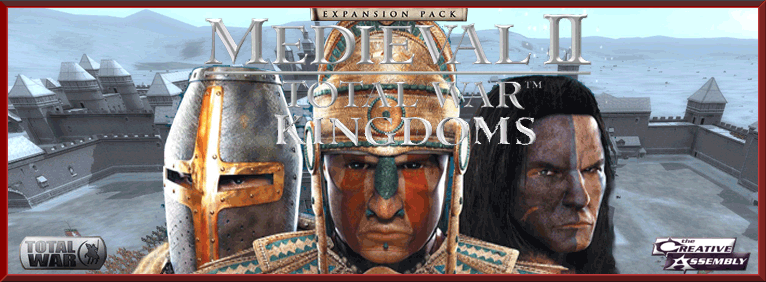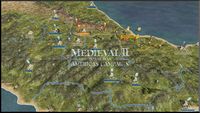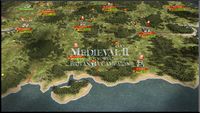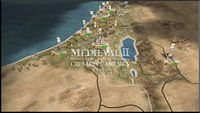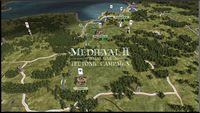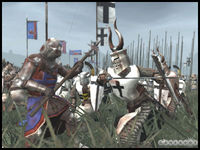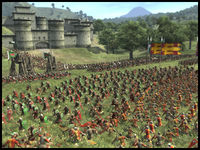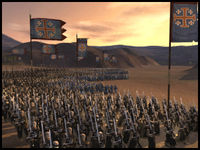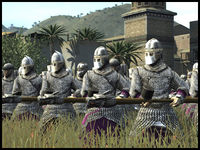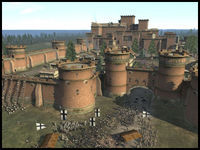Difference between revisions of "Medieval II: Total War: Kingdoms"
(→Units) |
|||
| (38 intermediate revisions by 17 users not shown) | |||
| Line 1: | Line 1: | ||
| + | [[File:Main-Kingdoms.gif|center]] | ||
| + | |||
{{Total War}} | {{Total War}} | ||
| − | |||
| − | |||
| − | == | + | '''Medieval II: Total War Kingdoms''' is the expansion to the 2006 PC game, ''[[Medieval II: Total War]]''. The expansion was released on August 28, 2007 in the United States and has four new campaigns, focusing on the discovery of the Americas, 13th century Britain, and Crusader campaigns in both the Levant and Northern Europe. |
| − | === | + | |
| + | ==Campaigns== | ||
| + | Medieval 2: Total War Kingdoms has 4 new campaigns, each one focusing on a different area. Each new campaign must be individually installed and the entire expansion pack takes up around 4 GB of hard drive space. Please note that when the factions list below states that a certain faction is non-playable then this applies ONLY to the Campaign game. You can play a quick game or a custom game with all the factions included. | ||
| + | |||
| + | ===Factions=== | ||
| + | ::''-See main article: [[:category:M2TW Kingdoms Factions|Medieval II: Total War Kingdoms Factions]]'' | ||
| + | |||
| + | ===Units=== | ||
| + | ::''-See main article: [[:category:M2TW Units|Medieval II: Total War Kingdoms Units]]'' | ||
| + | |||
| + | {{Cleanup}} | ||
| + | |||
| + | ==Americas Campaign== | ||
| + | [[Image:M2TW Americas.jpg|thumb|right|200px|alt=wallpaper.|Americas Strat Map]] | ||
| + | [[The Americas Campaign|The Americas campaign]] is set in the early sixteenth century, covering the early period of European colonisation of Central America. The Europeans must struggle with exploring an unknown land filled with violent natives, whilst the Native Americans attempt to stall foreign invasion whilst simultaneously expanding their own lands at the expense of their neighbours. | ||
| + | |||
| + | ===Faction Details=== | ||
| + | *'''[[New Spain (M2TW Kingdoms)|New Spain]]''', '''[[The Aztec Empire (M2TW Kingdoms)|Aztec Empire]]''', '''[[The Mayans (M2TW Kingdoms)|Mayans]]''', '''[[The Apachean Tribes (M2TW Kingdoms)|Apachean Tribes]]''', '''[[The Chichimec Tribes (M2TW Kingdoms)|Chichimeca]]''' (Unlockable), '''[[The Tlaxcalans Tribes (M2TW Kingdoms)|Tlaxcallans]]''' (Unlockable), '''[[The Tarascans Tribes (M2TW Kingdoms)|Tarascans]]''' (Unlockable), '''[[New France]]''' (non-playable), '''[[England (Americas Campaign)|England]]''' (non-playable). | ||
| + | |||
| + | ===Notable Features=== | ||
| + | This campaign implements the various conquistador armies that went to the new world by spawning large, formidable armies in the Americas with allegiance to New Spain. Once spawned, the New Spain faction can use these armies however they see fit. French and English forces will show up in the same way: the French in North America and the English in South America and Panama. | ||
| + | |||
| + | Also, when playing as New Spain, as the player progress through the campaign, they will be presented with missions from the King of Spain, and when sufficient influence is gained, the player may be granted a higher title of nobility, such as Baron, Count, etc. These titles unlock more advanced building levels for the player to use. | ||
| + | |||
| + | Playing as the Apache you have access to the "warpath" ability which is the equivalent of a crusade or jihad in Medieval 2: Total War. The Apache can also use the technology of colonizing factions- after battling a colonizing faction such as New Spain, the Apache will be able to construct gun trading Tipis and horse trainers. The Chichimeca can also use enemy technology to their advantage. | ||
| + | |||
| + | All of the factions that believe in the Sun God are able to sacrifice units instead of disbanding them. They can also sacrifice populations upon capturing a settlement or they can sacrifice captured enemy troops. Sacrificing upholds the religion of the Sun God and increases the happiness of your people. | ||
| + | |||
| + | ==Britannia Campaign== | ||
| + | [[Image:M2TW Britannia.jpg|thumb|right|200px|alt=wallpaper.|Britannia Strat Map]] | ||
| + | At the beginning of the [[The Britannia Campaign|Britannia campaign]] in 1258, the British Isles are in chaos. The [[England (M2TW Kingdoms)|Kingdom of England]] exercises influence over most of the Isles, but its power is contested from several theaters. In the far west, on Irish soil, England tenuously holds a network of fortresses that keep the Irish at bay. However, the chieftain Brian O'Neill has succeeded in uniting the Irish, and despite their lack of heavy infantry and financial difficulties, with a strong push they may seize the island. On the Marches, the Welsh have also been united, by Prince Llywelyn, who threatens the lightly held English border fortresses and rules over a people who simply refuse to be subjugated. In the north, the English are allied with the fierce Scots, but this bond is untenable, and the only remaining question is when war in the Highlands will erupt. Finally, the warlike Norwegians are returning to the Isles, having held the Isle of Man and the Hebrides for some time, their king coming personally to oversee the conquest of Britannia. England is the largest and richest faction in the isles, however they are very thinly spread, and incursions into their territories from the Welsh, Irish and even perhaps the Scots or Norwegians, seem inevitable unless action is taken. Perhaps worst of all, dissent smolders within its own borders, in the form of the English barons, who threaten to unify into a full-fledged rebellion. Time will tell who can come through blood and iron to unite Britannia. | ||
| + | |||
| + | ===Faction Details=== | ||
| + | '''[[England (M2TW Kingdoms)|Kingdom of England]]''', '''[[Scotland (M2TW Kingdoms)|Kingdom of Scotland]]''', '''[[Ireland (M2TW Kingdoms)|Kingdom of Ireland]]''', '''[[Wales (M2TW Kingdoms)|Principality of Wales]]''', '''[[Norway (M2TW Kingdoms)|Kingdom of Norway]]''', '''[[The Baron's Alliance (M2TW Kingdoms)|The Baron's Alliance]]''' (non-playable). | ||
| + | |||
| + | ===Notable Features=== | ||
| + | |||
| + | The presence of permanent stone forts placed in strategic locations (which can be garrisoned and provide free upkeep for a small number of units). These structures can hold out for a brief time against sieges and are automatically repaired after each battle. | ||
| + | |||
| + | Certain units can only be trained if that faction's culture is high enough in a settlement making expansion into conquered land more difficult. Culture has replaced religion in the game, and priest units are unavailable in this campaign. | ||
| + | |||
| + | A special, unplayable faction - [[The Baron's Alliance (M2TW Kingdoms)|The Baron's Alliance]] - similar in gameplay terms to the Eastern and Western Roman Rebels from the game [[Barbarian Invasion|Rome Total War: Barbarian Invasion]]. When characters, armies and settlements under English control rebel against their faction's control, they will become part of the Alliance, a faction with essentially the same strengths and weaknesses of the original faction, including the ability to utilize diplomacy and assassination to achieve their goals. | ||
| + | |||
| + | Every faction gets paid an additional amount of florins every turn. This payment is referred to as 'The King's Purse'. In ''Medieval 2: Total War'' some factions had a high king's purse payment every turn and some had a low payment, however rather than have a fixed king's purse, each faction in the Britannia Campaign has a Dynamic King's Purse- the sum of money you are paid every turn can change. | ||
| + | |||
| + | A number of special historical figures, including King Haakon of Norway, King Edward I, Prince Llywelyn of Wales, High King Brian O'Neill, and William Wallace, appearing either at the start of the campaign or at some later point. Though they lack the special abilities of the hero characters from the Crusades campaign, they are usually accompanied by a large army. | ||
| + | |||
| + | If any of the starting Welsh settlements are captured by the English, Welsh insurgents rise up in an attempt to recapture the settlements. The quality of the units in the rebel army will depend on which settlement is captured, for example the rebel army will be very strong if the starting Welsh capital- Caernarvon is captured, and it is a weaker army if smaller Welsh settlements are conquered (such as Pembroke). | ||
| + | |||
| + | ==Crusades Campaign== | ||
| + | [[Image:M2TW Crusades.jpg|thumb|right|200px|alt=wallpaper.|Crusades Strat Map]] | ||
| + | Beginning in 1174, the [[The Crusades Campaign|Crusades campaign]] is set several years prior to the outbreak of the Third Crusade, continuing into the Fourth Crusade and beyond. It follows the [[Kingdom of Jerusalem (M2TW Kingdoms)|Kingdom of Jerusalem]] and [[Principality of Antioch (M2TW Kingdoms)|Principality of Antioch]] as they attempt to strengthen the presence of Christendom in the Holy Lands, whilst the [[Turks (M2TW Kingdoms)|Seljuk Turks]] led by Nur ad-Din Zangi and the [[Egypt (M2TW Kingdoms)|Egyptians]] led by Saladin attempt to drive them out. Meanwhile, the [[The Byzantine Empire (M2TW Kingdoms)|Byzantium]] led by Emperor Manuel Komnenos slowly moves into the middle east to regain its lost glory, and attempts to drive back the armies of the Turks as well as deal with the rebels and the Venetians that harass them in the west. This scenario contains many historical inaccuracies. These include the fact that Nur ad-Din died in 1174 (the starting date for the scenario) and was actually succeeded by Salah al-Din (Saladin), the substantial enlargement of the Principality of Antioch to include areas that should be under Muslim control (such as Aleppo and Edessa), and the combination of Seljuk Turks of modern day Syria, Iraq and Jordan under Nur ad-Din with the Sultanate of Rum and the Danishmend Turcomans of Anatolia to form a unified group. | ||
| + | |||
| + | ===Faction Details=== | ||
| + | '''[[Kingdom of Jerusalem (M2TW Kingdoms)|Kingdom of Jerusalem]]''', '''[[Turks (M2TW Kingdoms)|Seljuk Turks]]''', '''[[Principality of Antioch (M2TW Kingdoms)|Principality of Antioch]]''', '''[[Egypt (M2TW Kingdoms)|Ayyubid Egypt]]''', '''[[The Byzantine Empire (M2TW Kingdoms)|Byzantium]]''', '''[[Mongol Empire (M2TW Kingdoms)|The Mongols]]''' (non-playable), '''[[Venice (M2TW Kingdoms|Republic of Venice]]''' (non-playable). | ||
| + | |||
| + | ===Notable Features=== | ||
| + | |||
| + | Generals in the Crusades campaign have the ability to construct permanent forts that remain even after vacated by troops. | ||
| + | |||
| + | The Principality of Antioch and Kingdom of Jerusalem may make use of the Knights Hospitaller and Knights Templar orders, respectively, thus giving them access to unique units - of whom only one of each may be present on the campaign map at one time. | ||
| + | |||
| + | Each of the five playable factions owns a single region designated as a "Power Centre", with the loss of these centres dealing a major blow to that faction. For example, the loss of a faction's Power Centre will prevent the recruitment of certain troop types. Should a Power Centre be lost, reinforcements will often be sent to assist in recapturing that settlement. | ||
| + | |||
| + | ====Heroes==== | ||
| + | |||
| + | Each playable faction has access to a single "Hero" character, these powerful individuals possessing special abilities capable of turning the tide of battle. | ||
| + | |||
| + | {| class="wikitable" | ||
| + | ! '''Faction''' !! '''Hero''' !! '''Ability''' | ||
| + | |- | ||
| + | |rowspan="1" | Kingdom of Jerusalem || Richard the Lionheart || Heart of the Lion: Immediately rallies any routing units. | ||
| + | |- | ||
| + | |rowspan="1" | Egypt || Saladin || Righteousness of Faith: Briefly sets all non-routing units' morale to full. | ||
| + | |- | ||
| + | |rowspan="1" | Seljuq Turks || Nur ad-Din Zangi || Light of the Faith: Briefly increases attack speed and morale of troops. | ||
| + | |- | ||
| + | |rowspan="1" | Byzantine Empire || Manuel Komnenos || Byzantine Politics: Causes infighting amongst an enemy unit, essentially removing them from play until order is restored or they are attacked. It can only be used once per battle. | ||
| + | |- | ||
| + | |rowspan="1" | Principality of Antioch || Philip II of France || Flower of Chivalry: Briefly increases attack power and stamina of troops. | ||
| + | |} | ||
| + | |||
| + | ==Teutonic Campaign== | ||
| + | [[Image:M2TW Teutonic.jpg|thumb|right|200px|alt=wallpaper.|Teutonic Strat Map]] | ||
| + | Starting from the date 1250, the [[The Teutonic Campaign|Teutonic campaign]] centres around the conflict between Christianity - spearheaded by the Teutonic Order - and Eastern European Paganism - represented by Lithuania. The Teutonic order are ruthless and are a threat not only to the Pagans but to the other countries also. Novgorod lies in the far east of the Baltic area and guard their rich city jealously. They have triumphed over the Teutonic Order in the past, but since then the Order has been rapidly expanding. Novgorod must build up their forces if they want to survive. The Duchy of Lithuania is desperate to drive off the Teutonic Order. If they want to be victorious, they must make use of their thick forests and quick forces to drive out the Order. However after much pressure from many of the Catholic factions the path of Catholicism may be inevitable for Lithuania. Lying to the west, the Danes hope to unite Scandinavia and from there launch attacks on the rest of the Baltic area. However, the mighty Holy Roman Empire lies directly to their south, and the Danes must make good use of their mass fleets if they hope to defeat their many enemies. As the Teutonic Knights' campaign against the Lithuanians continue, the Kingdom of Poland just to their south, having originally requested the Knights to deal with Lithuania, regret their decision, seeing the destruction brought by the Knights. wanting to right their wrong, they turn on the Teutonic Knights and wage war on them. | ||
| + | |||
| + | ===Faction Details=== | ||
| + | '''[[The Teutonic Order (M2TW Kingdoms)|Teutonic Order]]''', '''[[Denmark (M2TW Kingdoms)|Kingdom of Denmark]]''', '''[[Lithuania (M2TW Kingdoms)|Grand Duchy of Lithuania]]''', '''[[Novgorod (M2TW Kingdoms)|Novgorod Republic]]''', '''[[The Holy Roman Empire (M2TW Kingdoms)|Holy Roman Empire]]''' (Unlockable), '''[[Poland (M2TW Kingdoms)|Kingdom of Poland]]''' (Unlockable), '''[[Norway (M2TW Kingdoms)|Kingdom of Norway]]''' (non-playable), '''[[Golden Horde (Teutonic)|Mongol Empire]]''' (non-playable). | ||
| + | |||
| + | ===Notable Features=== | ||
| + | |||
| + | Crusading nobles, drawn to the conflict against Paganism in search of fame and glory, will request the assistance of the Teutonic Order in return for donations to the Order's coffers. The size of the donation varies depending on the nobles' successes. The Lithuanian leader will be rewarded by his council of nobles in the event that he should manage to kill any of these crusaders. | ||
| + | |||
| + | When playing as Denmark, it is possible for you to form the [[Kalmar Union (M2TW Kingdoms)|Union of Kalmar]]. In order to do this you must first take the Scandinavian settlements of Kalmar, Göteborg, Visby, Uppsala and Åbo. After taking control of these settlements you must then kill the Norwegian king, either through assassination or a direct battle. Note that if you eliminate the entire Norway faction it is impossible to form the union. After forming the union, Denmark will take on a new banner, gain access to all the existing settlements and armies of Norway, including its generals and agents and unlock the ability to build three new units. | ||
| − | + | Early in the campaign an event will herald the formation of The Hanseatic League. The League consists of five specific regions on the campaign map that represent the group's most important assets. The faction controlling the most of these settlements has the greatest chance to be offered the option of building the Hanseatic League Headquarters - a unique building that provides significant financial rewards. | |
| − | + | ====Features of the Teutonic Order==== | |
| − | |||
| − | |||
| − | |||
| − | |||
| − | === | + | Due to the unique nature of the Teutonic Order, it lacks a family tree - thus leaving princesses and certain diplomatic options closed to them but making the faction less vulnerable to assassins. Instead it is led by a Hochmeister, who, upon death, will be replaced by the most able General among the order's ranks. |
| − | + | ||
| − | + | Finally, the Order's best units can only be recruited in heavily Catholic areas. Recruiting units such as Christ Knights, Halbbruder and Ritterbruder thus requires an extremely high percentage of Catholics to be present in Teutonic-controlled regions. | |
| − | + | ||
| − | + | The Teutonic Order's strength is in its powerful heavy units. While lacking in speed, the Order's units more than make up for it in very powerful defensive strength. | |
| − | + | ||
| − | * | + | ====Features of Lithuania==== |
| − | * | + | |
| − | * | + | Lithuania starts out as a Pagan faction, offering it the chance to utilize a number of powerful and unique units to make up for its technological shortcomings. There are a number of different building options in a settlement that allow the faction to devote temples to three different Pagan deities. However, whilst following Paganism, Lithuania is unable to advance settlements beyond City or Castle level. |
| − | * | + | |
| + | At some point during the campaign, Lithuania will be presented with the option of converting to Christianity. Whilst this can cause significant unrest and will force the faction to remove any Pagan-specific buildings, units and agents, it will also unlock new building options and make Lithuania a less tempting target to the Christian factions that surround it. | ||
| + | |||
| + | ==Features== | ||
| + | * Four new campaigns. | ||
| + | * 23 playable factions: 13 new playable factions and 10 existing playable factions. | ||
| + | * Over 150 new units. | ||
| + | * Command reinforcements in battles (though not directly) | ||
| + | * Hero characters with special abilities. | ||
| + | * Build permanent forts and add moats to them. | ||
| + | * Castles and Cities can be renamed in game (but not regions) | ||
| + | * New siege weapons including boiling oil. | ||
| + | * New technology trees influenced by Religion and Prestige | ||
| + | * New mission types. | ||
| + | * 6 New Multiplayer scenarios and 20 new Custom Battle maps | ||
| + | * Compatibility with the new Hotseat multiplayer mode (Up to 2 human players - no human to human battle capability). | ||
| + | * 9 new types of agents (though renamed versions of agents from the original game)(mostly from the Americas campaign) | ||
| + | * Improved graphics for overall gameplay. | ||
==Screenshots== | ==Screenshots== | ||
| + | {| | ||
| + | | [[Image:M2K-1.jpg|thumb|upright|200px|alt=wallpaper.|]] | ||
| + | | [[Image:M2K-2.jpg|thumb|upright|200px|alt=wallpaper.|]] | ||
| + | | [[Image:M2K-3.jpg|thumb|upright|200px|alt=wallpaper.|]] | ||
| + | | [[Image:M2K-4.jpg|thumb|upright|200px|alt=wallpaper.|]] | ||
| + | | [[Image:M2K-5.jpg|thumb|upright|200px|alt=wallpaper.|]] | ||
| + | |} | ||
| + | |||
| + | |||
| + | ==System Requirements== | ||
| + | |||
| + | <u>'''The Minimum System Requirements are as follows:'''</u> | ||
| + | |||
| + | *English version of Microsoft® Windows® 2000/XP | ||
| + | *Celeron 1.5GHz Pentium 4® (1500MHz) or equivalent AMD® Athlon 64 | ||
| + | *512MB RAM | ||
| + | *DVD-ROM Drive capable of reading dual-layer DVDs | ||
| + | *9GB of uncompressed free hard disk space | ||
| + | *100% DirectX® 9.0c compatible 16-bit sound card and latest drivers | ||
| + | *100% Windows® 2000/XP compatible mouse, keyboard and latest drivers | ||
| + | *DirectX® 9.0c | ||
| + | *128MB Hardware Accelerated video card with Shader 1 support and the latest drivers. Must be 100% DirectX® 9.0c compatible*. The Nvidia® GeForce 4 Ti 4400 or the ATI radeon® 9600 SE is the recommended minimum video card. | ||
| + | *Monitor must be able to display 1024x768 resolution or above | ||
| + | |||
| + | <u>'''The Recommended System Requirements are as follows:'''</u> | ||
| + | |||
| + | *English version of Microsoft® Windows® XP | ||
| + | *Pentium 4® 2.4GHz (2400MHz) or equivalent AMD® Athlon 64 | ||
| + | *1GB RAM | ||
| + | *DVD-ROM Drive capable of reading dual-layer DVDs | ||
| + | *9GB of uncompressed free hard disk space | ||
| + | *Sound Blaster Audigy or equivalent | ||
| + | *100% Windows® 2000/XP compatible mouse, keyboard and latest drivers | ||
| + | *DirectX® 9.0c | ||
| + | *128MB Hardware Accelerated video card with Shader 2 support and the latest drivers. Must be 100% DirectX® 9.0c compatible*. The Nvidia® GeForce 7300 or greater, or the ATI Radeon® X1600 or greater is recommended. | ||
| + | *Monitor capable of displaying 1280x1024 resolution or above | ||
| + | |||
| + | <u>'''For the Launcher:'''</u> | ||
| − | + | *Internet Explorer 6 or Higher | |
| − | + | *A Connection to the Internet | |
| − | + | *Microsoft® .NET Framework 1.1 (Higher recommended)(installed with Medieval II) | |
| − | + | *Microsoft® J# Redistributable(installed with Medieval II) | |
| − | |||
| − | |||
| − | + | - Important Note: Please refer to your hardware | |
| − | + | manufacturer for confirmation of 100% DirectX® 9.0c compatibility. | |
| − | == | + | ==External Links== |
| − | *[[: | + | *Kingdoms on [http://www.gamespot.com/medieval-ii-total-war Gamespot.com] |
| − | *[http://www. | + | *Kingdoms on [http://pc.ign.com/articles/777/777518p1.html IGN.com] |
| + | *Kingdoms on [http://pc.gamespy.com/pc/medieval-ii-total-war-kingdoms/817832p1.html Gamespy.com] | ||
| + | *Kingdoms on [http://www.strategyinformer.com/pc/medievaliitotalwarkingdoms/ Strategyinformer.com] | ||
| − | [[Category: Total War Series]] | + | [[Category:Total War Series]] |
| − | [[Category: | + | [[Category:M2TW Information]] |
| + | [[Category:M2TW Kingdoms Information]] | ||
Latest revision as of 11:36, 15 March 2020
| Total War Series |
|---|
|
Total War: Three Kingdoms - Portal Total War Saga: Thrones of Britannia Medieval II: Total War - Portal |
Medieval II: Total War Kingdoms is the expansion to the 2006 PC game, Medieval II: Total War. The expansion was released on August 28, 2007 in the United States and has four new campaigns, focusing on the discovery of the Americas, 13th century Britain, and Crusader campaigns in both the Levant and Northern Europe.
Contents
Campaigns
Medieval 2: Total War Kingdoms has 4 new campaigns, each one focusing on a different area. Each new campaign must be individually installed and the entire expansion pack takes up around 4 GB of hard drive space. Please note that when the factions list below states that a certain faction is non-playable then this applies ONLY to the Campaign game. You can play a quick game or a custom game with all the factions included.
Factions
- -See main article: Medieval II: Total War Kingdoms Factions
Units
- -See main article: Medieval II: Total War Kingdoms Units

|
This article needs some additions or rewriting. Please discuss this issue on the talk page, or contact Wiki Staff. Please remove this tag when the page has been improved. |
Americas Campaign
The Americas campaign is set in the early sixteenth century, covering the early period of European colonisation of Central America. The Europeans must struggle with exploring an unknown land filled with violent natives, whilst the Native Americans attempt to stall foreign invasion whilst simultaneously expanding their own lands at the expense of their neighbours.
Faction Details
- New Spain, Aztec Empire, Mayans, Apachean Tribes, Chichimeca (Unlockable), Tlaxcallans (Unlockable), Tarascans (Unlockable), New France (non-playable), England (non-playable).
Notable Features
This campaign implements the various conquistador armies that went to the new world by spawning large, formidable armies in the Americas with allegiance to New Spain. Once spawned, the New Spain faction can use these armies however they see fit. French and English forces will show up in the same way: the French in North America and the English in South America and Panama.
Also, when playing as New Spain, as the player progress through the campaign, they will be presented with missions from the King of Spain, and when sufficient influence is gained, the player may be granted a higher title of nobility, such as Baron, Count, etc. These titles unlock more advanced building levels for the player to use.
Playing as the Apache you have access to the "warpath" ability which is the equivalent of a crusade or jihad in Medieval 2: Total War. The Apache can also use the technology of colonizing factions- after battling a colonizing faction such as New Spain, the Apache will be able to construct gun trading Tipis and horse trainers. The Chichimeca can also use enemy technology to their advantage.
All of the factions that believe in the Sun God are able to sacrifice units instead of disbanding them. They can also sacrifice populations upon capturing a settlement or they can sacrifice captured enemy troops. Sacrificing upholds the religion of the Sun God and increases the happiness of your people.
Britannia Campaign
At the beginning of the Britannia campaign in 1258, the British Isles are in chaos. The Kingdom of England exercises influence over most of the Isles, but its power is contested from several theaters. In the far west, on Irish soil, England tenuously holds a network of fortresses that keep the Irish at bay. However, the chieftain Brian O'Neill has succeeded in uniting the Irish, and despite their lack of heavy infantry and financial difficulties, with a strong push they may seize the island. On the Marches, the Welsh have also been united, by Prince Llywelyn, who threatens the lightly held English border fortresses and rules over a people who simply refuse to be subjugated. In the north, the English are allied with the fierce Scots, but this bond is untenable, and the only remaining question is when war in the Highlands will erupt. Finally, the warlike Norwegians are returning to the Isles, having held the Isle of Man and the Hebrides for some time, their king coming personally to oversee the conquest of Britannia. England is the largest and richest faction in the isles, however they are very thinly spread, and incursions into their territories from the Welsh, Irish and even perhaps the Scots or Norwegians, seem inevitable unless action is taken. Perhaps worst of all, dissent smolders within its own borders, in the form of the English barons, who threaten to unify into a full-fledged rebellion. Time will tell who can come through blood and iron to unite Britannia.
Faction Details
Kingdom of England, Kingdom of Scotland, Kingdom of Ireland, Principality of Wales, Kingdom of Norway, The Baron's Alliance (non-playable).
Notable Features
The presence of permanent stone forts placed in strategic locations (which can be garrisoned and provide free upkeep for a small number of units). These structures can hold out for a brief time against sieges and are automatically repaired after each battle.
Certain units can only be trained if that faction's culture is high enough in a settlement making expansion into conquered land more difficult. Culture has replaced religion in the game, and priest units are unavailable in this campaign.
A special, unplayable faction - The Baron's Alliance - similar in gameplay terms to the Eastern and Western Roman Rebels from the game Rome Total War: Barbarian Invasion. When characters, armies and settlements under English control rebel against their faction's control, they will become part of the Alliance, a faction with essentially the same strengths and weaknesses of the original faction, including the ability to utilize diplomacy and assassination to achieve their goals.
Every faction gets paid an additional amount of florins every turn. This payment is referred to as 'The King's Purse'. In Medieval 2: Total War some factions had a high king's purse payment every turn and some had a low payment, however rather than have a fixed king's purse, each faction in the Britannia Campaign has a Dynamic King's Purse- the sum of money you are paid every turn can change.
A number of special historical figures, including King Haakon of Norway, King Edward I, Prince Llywelyn of Wales, High King Brian O'Neill, and William Wallace, appearing either at the start of the campaign or at some later point. Though they lack the special abilities of the hero characters from the Crusades campaign, they are usually accompanied by a large army.
If any of the starting Welsh settlements are captured by the English, Welsh insurgents rise up in an attempt to recapture the settlements. The quality of the units in the rebel army will depend on which settlement is captured, for example the rebel army will be very strong if the starting Welsh capital- Caernarvon is captured, and it is a weaker army if smaller Welsh settlements are conquered (such as Pembroke).
Crusades Campaign
Beginning in 1174, the Crusades campaign is set several years prior to the outbreak of the Third Crusade, continuing into the Fourth Crusade and beyond. It follows the Kingdom of Jerusalem and Principality of Antioch as they attempt to strengthen the presence of Christendom in the Holy Lands, whilst the Seljuk Turks led by Nur ad-Din Zangi and the Egyptians led by Saladin attempt to drive them out. Meanwhile, the Byzantium led by Emperor Manuel Komnenos slowly moves into the middle east to regain its lost glory, and attempts to drive back the armies of the Turks as well as deal with the rebels and the Venetians that harass them in the west. This scenario contains many historical inaccuracies. These include the fact that Nur ad-Din died in 1174 (the starting date for the scenario) and was actually succeeded by Salah al-Din (Saladin), the substantial enlargement of the Principality of Antioch to include areas that should be under Muslim control (such as Aleppo and Edessa), and the combination of Seljuk Turks of modern day Syria, Iraq and Jordan under Nur ad-Din with the Sultanate of Rum and the Danishmend Turcomans of Anatolia to form a unified group.
Faction Details
Kingdom of Jerusalem, Seljuk Turks, Principality of Antioch, Ayyubid Egypt, Byzantium, The Mongols (non-playable), Republic of Venice (non-playable).
Notable Features
Generals in the Crusades campaign have the ability to construct permanent forts that remain even after vacated by troops.
The Principality of Antioch and Kingdom of Jerusalem may make use of the Knights Hospitaller and Knights Templar orders, respectively, thus giving them access to unique units - of whom only one of each may be present on the campaign map at one time.
Each of the five playable factions owns a single region designated as a "Power Centre", with the loss of these centres dealing a major blow to that faction. For example, the loss of a faction's Power Centre will prevent the recruitment of certain troop types. Should a Power Centre be lost, reinforcements will often be sent to assist in recapturing that settlement.
Heroes
Each playable faction has access to a single "Hero" character, these powerful individuals possessing special abilities capable of turning the tide of battle.
| Faction | Hero | Ability |
|---|---|---|
| Kingdom of Jerusalem | Richard the Lionheart | Heart of the Lion: Immediately rallies any routing units. |
| Egypt | Saladin | Righteousness of Faith: Briefly sets all non-routing units' morale to full. |
| Seljuq Turks | Nur ad-Din Zangi | Light of the Faith: Briefly increases attack speed and morale of troops. |
| Byzantine Empire | Manuel Komnenos | Byzantine Politics: Causes infighting amongst an enemy unit, essentially removing them from play until order is restored or they are attacked. It can only be used once per battle. |
| Principality of Antioch | Philip II of France | Flower of Chivalry: Briefly increases attack power and stamina of troops. |
Teutonic Campaign
Starting from the date 1250, the Teutonic campaign centres around the conflict between Christianity - spearheaded by the Teutonic Order - and Eastern European Paganism - represented by Lithuania. The Teutonic order are ruthless and are a threat not only to the Pagans but to the other countries also. Novgorod lies in the far east of the Baltic area and guard their rich city jealously. They have triumphed over the Teutonic Order in the past, but since then the Order has been rapidly expanding. Novgorod must build up their forces if they want to survive. The Duchy of Lithuania is desperate to drive off the Teutonic Order. If they want to be victorious, they must make use of their thick forests and quick forces to drive out the Order. However after much pressure from many of the Catholic factions the path of Catholicism may be inevitable for Lithuania. Lying to the west, the Danes hope to unite Scandinavia and from there launch attacks on the rest of the Baltic area. However, the mighty Holy Roman Empire lies directly to their south, and the Danes must make good use of their mass fleets if they hope to defeat their many enemies. As the Teutonic Knights' campaign against the Lithuanians continue, the Kingdom of Poland just to their south, having originally requested the Knights to deal with Lithuania, regret their decision, seeing the destruction brought by the Knights. wanting to right their wrong, they turn on the Teutonic Knights and wage war on them.
Faction Details
Teutonic Order, Kingdom of Denmark, Grand Duchy of Lithuania, Novgorod Republic, Holy Roman Empire (Unlockable), Kingdom of Poland (Unlockable), Kingdom of Norway (non-playable), Mongol Empire (non-playable).
Notable Features
Crusading nobles, drawn to the conflict against Paganism in search of fame and glory, will request the assistance of the Teutonic Order in return for donations to the Order's coffers. The size of the donation varies depending on the nobles' successes. The Lithuanian leader will be rewarded by his council of nobles in the event that he should manage to kill any of these crusaders.
When playing as Denmark, it is possible for you to form the Union of Kalmar. In order to do this you must first take the Scandinavian settlements of Kalmar, Göteborg, Visby, Uppsala and Åbo. After taking control of these settlements you must then kill the Norwegian king, either through assassination or a direct battle. Note that if you eliminate the entire Norway faction it is impossible to form the union. After forming the union, Denmark will take on a new banner, gain access to all the existing settlements and armies of Norway, including its generals and agents and unlock the ability to build three new units.
Early in the campaign an event will herald the formation of The Hanseatic League. The League consists of five specific regions on the campaign map that represent the group's most important assets. The faction controlling the most of these settlements has the greatest chance to be offered the option of building the Hanseatic League Headquarters - a unique building that provides significant financial rewards.
Features of the Teutonic Order
Due to the unique nature of the Teutonic Order, it lacks a family tree - thus leaving princesses and certain diplomatic options closed to them but making the faction less vulnerable to assassins. Instead it is led by a Hochmeister, who, upon death, will be replaced by the most able General among the order's ranks.
Finally, the Order's best units can only be recruited in heavily Catholic areas. Recruiting units such as Christ Knights, Halbbruder and Ritterbruder thus requires an extremely high percentage of Catholics to be present in Teutonic-controlled regions.
The Teutonic Order's strength is in its powerful heavy units. While lacking in speed, the Order's units more than make up for it in very powerful defensive strength.
Features of Lithuania
Lithuania starts out as a Pagan faction, offering it the chance to utilize a number of powerful and unique units to make up for its technological shortcomings. There are a number of different building options in a settlement that allow the faction to devote temples to three different Pagan deities. However, whilst following Paganism, Lithuania is unable to advance settlements beyond City or Castle level.
At some point during the campaign, Lithuania will be presented with the option of converting to Christianity. Whilst this can cause significant unrest and will force the faction to remove any Pagan-specific buildings, units and agents, it will also unlock new building options and make Lithuania a less tempting target to the Christian factions that surround it.
Features
- Four new campaigns.
- 23 playable factions: 13 new playable factions and 10 existing playable factions.
- Over 150 new units.
- Command reinforcements in battles (though not directly)
- Hero characters with special abilities.
- Build permanent forts and add moats to them.
- Castles and Cities can be renamed in game (but not regions)
- New siege weapons including boiling oil.
- New technology trees influenced by Religion and Prestige
- New mission types.
- 6 New Multiplayer scenarios and 20 new Custom Battle maps
- Compatibility with the new Hotseat multiplayer mode (Up to 2 human players - no human to human battle capability).
- 9 new types of agents (though renamed versions of agents from the original game)(mostly from the Americas campaign)
- Improved graphics for overall gameplay.
Screenshots
System Requirements
The Minimum System Requirements are as follows:
- English version of Microsoft® Windows® 2000/XP
- Celeron 1.5GHz Pentium 4® (1500MHz) or equivalent AMD® Athlon 64
- 512MB RAM
- DVD-ROM Drive capable of reading dual-layer DVDs
- 9GB of uncompressed free hard disk space
- 100% DirectX® 9.0c compatible 16-bit sound card and latest drivers
- 100% Windows® 2000/XP compatible mouse, keyboard and latest drivers
- DirectX® 9.0c
- 128MB Hardware Accelerated video card with Shader 1 support and the latest drivers. Must be 100% DirectX® 9.0c compatible*. The Nvidia® GeForce 4 Ti 4400 or the ATI radeon® 9600 SE is the recommended minimum video card.
- Monitor must be able to display 1024x768 resolution or above
The Recommended System Requirements are as follows:
- English version of Microsoft® Windows® XP
- Pentium 4® 2.4GHz (2400MHz) or equivalent AMD® Athlon 64
- 1GB RAM
- DVD-ROM Drive capable of reading dual-layer DVDs
- 9GB of uncompressed free hard disk space
- Sound Blaster Audigy or equivalent
- 100% Windows® 2000/XP compatible mouse, keyboard and latest drivers
- DirectX® 9.0c
- 128MB Hardware Accelerated video card with Shader 2 support and the latest drivers. Must be 100% DirectX® 9.0c compatible*. The Nvidia® GeForce 7300 or greater, or the ATI Radeon® X1600 or greater is recommended.
- Monitor capable of displaying 1280x1024 resolution or above
For the Launcher:
- Internet Explorer 6 or Higher
- A Connection to the Internet
- Microsoft® .NET Framework 1.1 (Higher recommended)(installed with Medieval II)
- Microsoft® J# Redistributable(installed with Medieval II)
- Important Note: Please refer to your hardware
manufacturer for confirmation of 100% DirectX® 9.0c compatibility.
External Links
- Kingdoms on Gamespot.com
- Kingdoms on IGN.com
- Kingdoms on Gamespy.com
- Kingdoms on Strategyinformer.com
